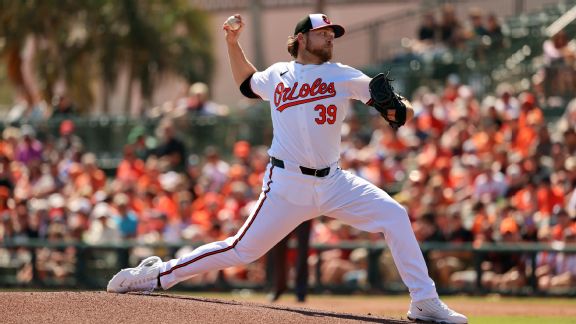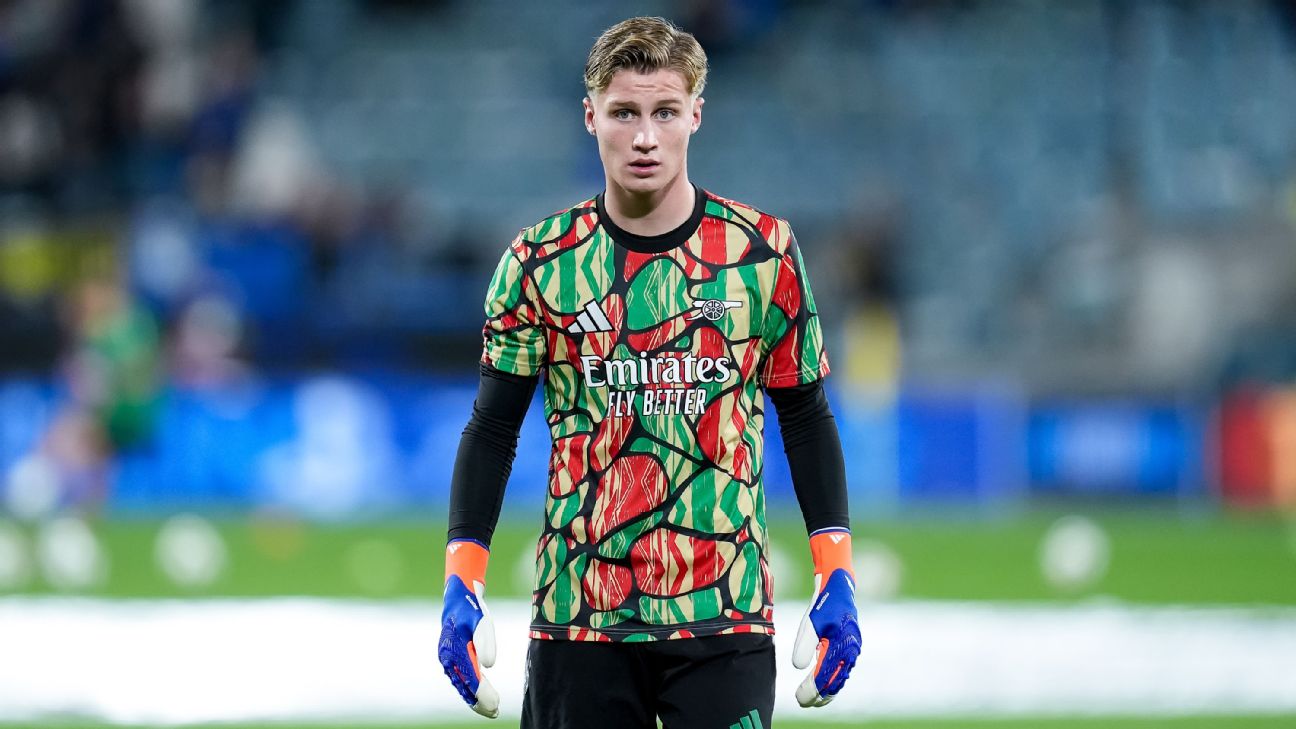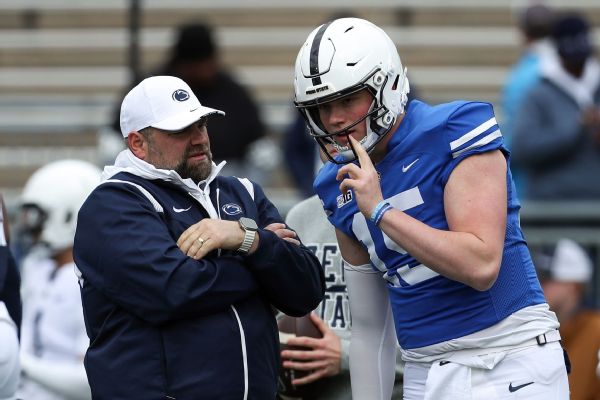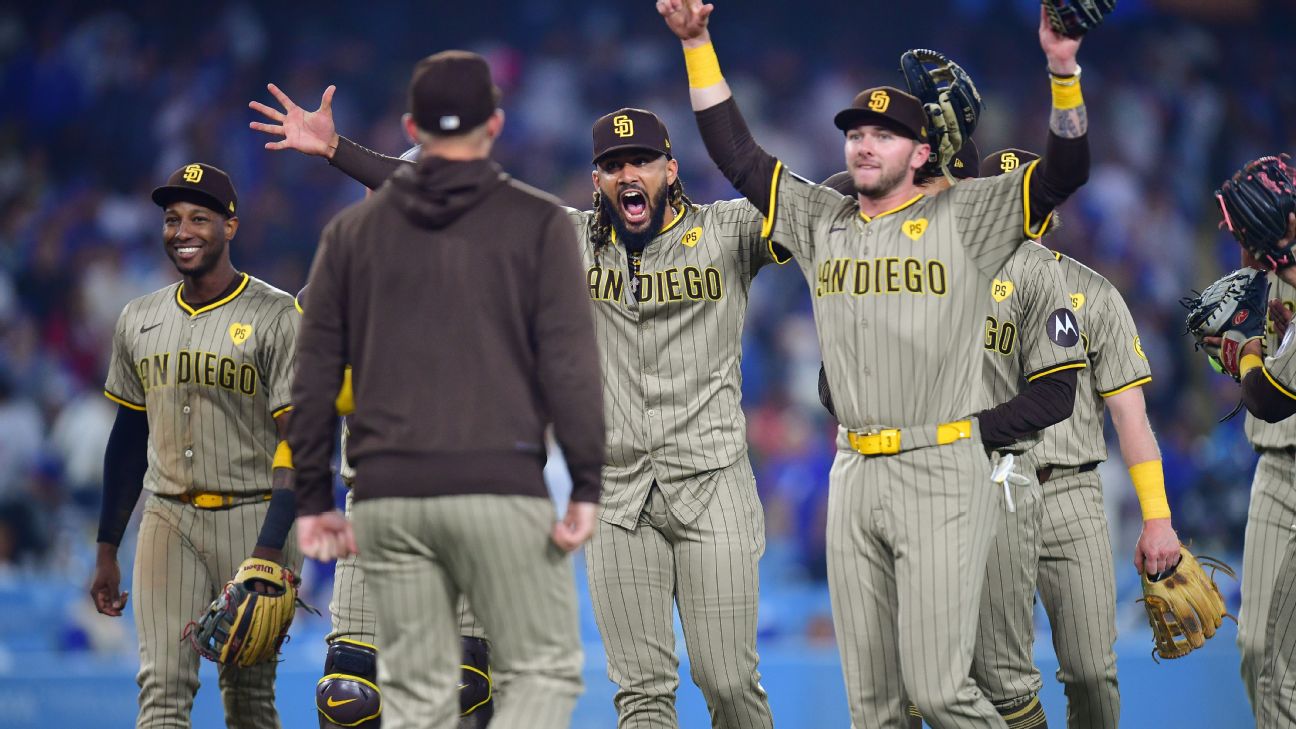![Cleveland_Guardians_BDSMS [608x342]](https://a.espncdn.com/photo/2024/0927/r1392771_608x342_16-9.jpg)
Chargers rule out Bosa Slater Herbert still iffy
Sometimes it's not about having more, but about doing more with less.
When the MLB playoffs commence in a few days, the two largest-revenue teams in baseball -- the New York Yankees and Los Angeles Dodgers -- will enter the fray as popular picks to meet in the World Series. The New York Mets, Yankees, Philadelphia Phillies, Houston Astros and Dodgers own baseball's five biggest payrolls, based on data from Spotrac. If the Mets nail down one of the National League's remaining wild-card slots, all five will move on to October.
Money in, money out. It's a time-honored formula for winning in baseball. Still, this year's postseason bracket will also feature a number of teams on lower revenue and payroll tiers. According to revenue figures included in Forbes' annual valuations of MLB clubs, it's likely that half of the playoff bracket will comprise teams ranking 18th or lower.
Two of those teams aren't really surprise entrants. The Baltimore Orioles (No. 18 in revenue) won more than 100 games last season and the Arizona Diamondbacks (No. 22) won last season's NL pennant. The other four -- the Kansas City Royals (No. 26), Detroit Tigers (No. 25), Cleveland Guardians (No. 20) and Milwaukee Brewers (No. 19) -- are very much surprises.
Each has upended expectations this season, without the considerable economic might of baseball's biggest earners. Let's dig into that quartet to see what secrets, if any, they might reveal.
What makes these four teams special?The playoff probability of a team that makes the playoffs is, by definition, 100%. If we consider the five most surprising teams as those who have added the most probability to reach that number since Opening Day, four of them come from that low-revenue group. The initial probabilities from this spring are based on my last preseason run of simulations:
Only the San Diego Padres, middle tier in revenue and payroll, break the hegemony of our surprise small-market playoff teams. Thus the Royals, Tigers, Brewers and Guardians have a number of things in common that make them worth comparing. Those are:
• None of the four were considered better than a 50-50 proposition to make the playoffs when the season began.
• All four rank in the bottom two-fifths of baseball's revenue hierarchy.
• All four rank 18th or lower in terms of metropolitan-area population. Cleveland, Kansas City and Milwaukee are the bottom three.
• All four play in baseball's Central divisions.
To compare them, we'll make some quick observations of different facets of fielding and running a big league club, attaching metrics where we can. These will be a combination of publicly available metrics as well as different indexes I calculate and track through the season. Then we'll quickly sum up the leading drivers of each team's surprising success in 2024.
All revenue estimates are from the Forbes valuations of the 2023 season, and all payroll rankings are based on Spotrac data. In the depth sections, I'm using my AXE ratings to put players into performance buckets. AXE is simply a consensus measure of leading value metrics (bWAR, fWAR, win probability added and championship probability added).
Cleveland GuardiansResources: Cleveland ranks 20th in revenue and has baseball's 23rd-ranked payroll. Given the Guardians' current win pace entering the last few days of the season, they have spent $1.14 million per win, the fifth-most efficient showing in baseball.
Farm system: Entering the season, ESPN's Kiley McDaniel ranked the Guardians' system 19th, down from third in 2023. According to roster breakdowns at FanGraphs, Cleveland's count of 16 homegrown players is third highest in baseball. Cleveland's .553 minor league winning percentage this season was second best in baseball. They rank 11th in WAR from rookies.
Moves: Cleveland ranked 27th in free agent spending during the most recent offseason, per Spotrac. According to an index of in-season acquisitions I calculate based on consensus WAR, the Guardians rank 19th.
Health: According to the injury index I monitor based on data from Baseball Prospectus, the Guardians rank 11th overall. This is a combination of the quantity of injuries and the quality of those missing time. For the Guardians, the big blow was the early season-ending injury suffered by ace Shane Bieber.
Hitters: The Guardians rank 14th in scoring and have a 98 OPS+, per Baseball Reference. They rank fourth in lowest strikeout rate and eighth in homer rate. Cleveland has scored 41.7% of its runs via home run, ranking eighth, but the team also ranks fifth in stolen bases. The Guardians rank eighth in fielding, per FanGraphs' DEF metric. Also, the Guardians feature baseball's youngest position group (26.2 average age, per Baseball Reference).
Pitchers: Cleveland ranks 23rd in starter innings, 28th in quality starts and 23rd in rotation ERA. The relievers have the second-most saves, the most holds and the top overall ERA. Cleveland ranks eighth in bullpen innings. Overall, the Guardians rank third in runs allowed per game.
Depth: The Guardians have a typical distribution of production. They're better than the MLB average in All-Star-level contributors (15%) and above-average performances (36%).
The bottom line: The Guardians have been approaching things this way for years. They don't go big in free agency and are often maddeningly passive when it comes to making splashy in-season moves. The roster they've built this year features plus defense and a high number of stolen bases.
The Guardians have been a high-contact team in recent years, but this year they've become more homer reliant, echoing the best Cleveland teams of the past decade. Finally, with a young rotation that has dealt with injury absences from Bieber and others, the Guardians have leaned heavily on a power-laden bullpen that has performed better than any relief staff in baseball.
Detroit TigersResources: Detroit ranks 25th in revenue and has baseball's 26th-ranked payroll. Given the Tigers' current win pace entering the last few days of the season, they have spent $1.13 million per win, the fourth-most efficient showing in baseball.
Farm system: McDaniel ranked the Tigers third in his preseason rankings, up from 21st in 2023. Their 17 homegrown players make up the second-highest total in baseball. Detroit's organizational winning percentage this season (.555) was the best in baseball. They rank 10th in WAR from rookies.
Moves: Detroit ranked 14th in free agent spending last winter. Its in-season acquisition index ranks 21st, typical of an offloading club. Nominally speaking, that's what the Tigers were at the trade deadline, dealing away starter Jack Flaherty and reliever Andrew Chafin.
Health: The Tigers have the second-best injury index in the majors. Their most significant lingering injury down the stretch has been starting shortstop Javier Baez. However, Baez (45 OPS+) was playing so poorly that replacement Trey Sweeney has been an upgrade.
Hitters: A generous description of the Detroit offense is that it has been opportunistic. The Tigers are 19th in runs per game despite ranking 28th in OBP, 22nd in slugging and 26th in steals. A saving grace has been a 10th-ranked performance with runners in scoring position. Defensively, the Tigers rank ninth in DEF. They feature the fifth-youngest position group.
Pitchers: The Tigers have given up the fourth-fewest runs in baseball and allowed the second-lowest OPS. After the trade of Flaherty, the Tigers began to aggressively use openers in lieu of a set rotation. Detroit ranks last in total pitches thrown by starters -- but led by left-hander Tarik Skubal, a strong favorite for AL Cy Young honors, the rotation ranks fourth in ERA. Meanwhile, the bullpen has developed into a strong, deep group that has been red-hot down the stretch. Detroit leads the majors in reliever innings while ranking second in bullpen WHIP and fourth in ERA.
Depth: Skubal (139 AXE) and Riley Greene (127) give Detroit All-Star-caliber foundations for both the pitching and hitting group. Where Detroit has quietly excelled is avoiding excessively poor seasons from key players, Baez aside. Detroit has had 22 players appear with below-average AXE ratings -- the lowest total in the majors.
The bottom line: The Tigers have had some good fortune in areas like injury prevention and clutch hitting, and by winning an MLB-high 31 one-run games. By the same token, this is a team built for tense, low-scoring games, and manager A.J. Hinch has done a superlative job in leaning heavily on his bullpen over the season's past few weeks.
This strategy has coincided with Detroit's increased reliance on ascending young players and others, such as Spencer Torkelson, who have improved as the season has progressed. The latest example is hard-throwing Jackson Jobe, just recalled for his MLB debut last week. He joins a team that's already in playoff mode and has been for a month.
In a year's time, we might look at this Tigers team as one that arrived just in time for a playoff appearance in 2024 but with expectations of contention going forward.
Kansas City RoyalsResources: Kansas City ranks 26th in revenue and has baseball's 20th-ranked payroll. Given the Royals' current win pace entering the last few days of the season, they have spent $1.39 million per win, the ninth-most efficient showing in baseball.
Farm system: McDaniel ranked the Royals 26th before the season, up from 28th last season. Their total of 13 homegrown players is tied for the fifth most. Kansas City's organizational winning percentage (.513) ranks 14th. Only two teams have received less production in terms of WAR from rookies.
Moves: The Royals ranked sixth in free agent spending last winter. Kansas City also aggressively added players via trades and waiver claims before, at and after the trade deadline. The Royals rank fifth in my in-season acquisition index.
Health: Despite a late-season injury to standout first baseman Vinnie Pasquantino, the Royals rank third in the injury index. They've been particularly fortunate in the starting pitching group, where Kansas City's five most-used hurlers will account for 151 outings by season's end.
Hitters: Following the classic Royals model, Kansas City's offense has been built on contact and speed. Only the Washington Nationals have scored a lower percentage of their runs via the home run ball. Kansas City ranks 10th in stolen bases but have a key late-inning weapon in outfielder Dairon Blanco. Of Blanco's 31 steals, 21 have come in off-the-bench situations. The Royals also rank second in average with runners in scoring position, though they've struggled in that area since Pasquantino was injured. In terms of RBIs above expectation (i.e., runs driven in above or below average given each hitter's RBI opportunities), Pasquantino and Royals star Bobby Witt Jr. have ranked first and second in the majors for the past three months. Defensively, the Royals lead the majors in DEF.
Pitchers: The Royals signed veteran starters Michael Wacha and Seth Lugo during their surprisingly aggressive offseason. Those two have helped fill out a starting staff that has been baseball's most durable and consistent. The Royals lead the majors in innings from starters, rank third in quality starts and second in ERA. The bullpen has been a jigsaw puzzle (and one reason the Royals are just 29-36 in games decided by one or two runs). But the deadline pickup of Lucas Erceg has given the Royals a late-inning hammer and, over the past couple of weeks, the group has functioned better behind Erceg, right-hander John Schreiber, resurgent lefty Angel Zerpa and converted starters Daniel Lynch IV and Kris Bubic. After a somewhat passive approach with the bullpen roster during the first half, the Royals have aggressively iterated it during the second half.
Depth: Here, the Royals are lacking. They've gotten by because of relatively good health and the willingness of the front office to go outside the organization to fill pressing needs. When Pasquantino went down, the Royals responded by quickly adding Tommy Pham, Robbie Grossman and Yuli Gurriel in short order, and all have contributed. Kansas City's foundation is surprisingly star-laden. Everyone knows about Witt, whose 163 AXE will make him one of the best non-MVPs in history. But starters Lugo and Cole Ragans are also both over 130, making Kansas City the only club with a trio of 130-plus performers.
The bottom line: The Royals are a low-revenue team in one of the league's smallest markets. They were coming off a 106-loss season and ranked poorly in prospect rankings. Yet they were aggressive in free agency last winter and mindful in how they were adding. They were aggressive in filling in gaps at the deadline despite their subpar prospect inventory. When injuries finally bit them in late August, they were aggressive on the waiver wire.
The Royals have become a team built on the franchise's pillars of speed, defense, contact hitting and starting pitching that is more about consistency than dominance. They've gotten there by leveraging all of their available resources to make the 26-man roster as strong as it can be at any given time. It's a Dave Dombrowski-esque approach to roster building, and it looks as if it has resulted in one of the most stunning one-season turnarounds we've ever seen.
Milwaukee BrewersResources: Milwaukee ranks 19th in revenue and has baseball's 21st-ranked payroll. Given the Brewers' current win pace entering the last few days of the season, they have spent $1.24 million per win, the seventh-most efficient showing in baseball.
Farm system: McDaniel ranked the Brewers fifth before the season, up from 15th in 2023. Their organizational winning percentage (.549) ranks third in the majors. No team has gotten more WAR from rookies.
Moves: The Brewers ranked 11th in free agent spending, per Spotrac. The biggest free agent contributors have been first baseman Rhys Hoskins and catcher Gary Sanchez. The other two biggest offseason investments were for pitchers on the IL (Brandon Woodruff and Wade Miley). The Brewers rank 15th by my in-season acquisition index based on a low volume of moves.
Health: The Brewers rank 20th in the injury index. Woodruff's season-long absence was built into the team's planning for 2024, but Milwaukee has had to work around key injuries to Miley, rookie starter Robert Gasser and franchise star outfielder Christian Yelich.
Hitters: The Brewers generally rank high in the three true outcomes, and this season is no exception. No team has swung at fewer first pitches. But the Milwaukee offense, which ranks sixth in runs per game, has been a surprise unit because it has augmented those traits with more contact and a lot more speed. The Brewers rank eighth in average and fourth in BABIP, sixth in average with runners in scoring position and second in stolen bases. According to Statcast, the Brewers have the highest collective sprint speed in baseball. All of that speed pays off on defense, where the Brewers rank third in DEF. Milwaukee has the third-youngest position group.
Pitchers: The Brewers in their previous incarnation were built around a pitching staff that featured a big three rotation (Woodruff, Corbin Burnes and Freddy Peralta) and an end-of-the-bullpen hammer (Josh Hader, then Devin Williams). Woodruff is hurt, Burnes was traded to Baltimore and Williams' season didn't start until right before the trade deadline. To compensate, the Brewers went with a bullpen-heavy model based on multiple high-leverage options, all of which thrived on an organizational trait: identifying pitchers they can make better. Milwaukee ranks 29th in quality starts and 26th in rotation innings. But its relievers have the second-best bullpen ERA and rank fourth in innings.
Depth: The Brewers have 19 players with AXE ratings between 100 and 129, but no one at 130 or above, joining the Padres as the only other postseason entrant without a superstar turn. On the flip side, the Brewers have no players in the "bust" bucket (an AXE under 90). Taken as a whole, Milwaukee has the roster with the lowest level of performance polarization in baseball.
The bottom line: In a way, the Brewers are a surprise to be considered a surprise. After all, they've been a playoff fixture in recent years and haven't been out of the running for a postseason slot in the late stages of a season since 2016. Still, this was supposed to be a transition season, with Burnes and Woodruff gone, along with ace manager Craig Counsell, and the team turning over a number of spots to young players.
Milwaukee hasn't skipped a beat but what's truly amazing about this version of the Brewers is that they've maintained their success despite fielding a very different kind of team. This version succeeds with dynamic young players all over the place, such as Jackson Chourio, Brice Turang, Sal Frelick and Garrett Mitchell, and is even more fun to watch. The Brewers don't have a catchy brand name for the way they do things, but they probably should. Because this might very well be the best-run team in the majors.
So what's the secret?It should not come as a surprise that no magic bullet emerged through this investigation. Each of these teams has won in its own way, and deployed different strategies in everything from roster building to resource management to on-field style of play. The bottom line for all of them is that it has worked.
Some themes crop up a lot, though. These teams are young and largely homegrown. They tend to feature deep, power bullpens. They are seeing the fruits of consistent minor league success, including this season. Yet this doesn't explain them all, because the Royals are the exception to most of these things.
If there is one thing we can say about the Brewers, Guardians, Royals and Tigers it's this: Whether it was a team in transition (Brewers), or a team trying to emerge from a rebuild (Royals, Tigers) or a team that sticks close to its organizational mantra (Guardians), none of them conceded the 2024 season at any point. This seems as if it would be true for every team but, let's face it, too often it's not.
In other words, the key lesson we can learn from these teams -- and the first step toward becoming a surprise playoff entrant -- might simply be this: You have to try.







